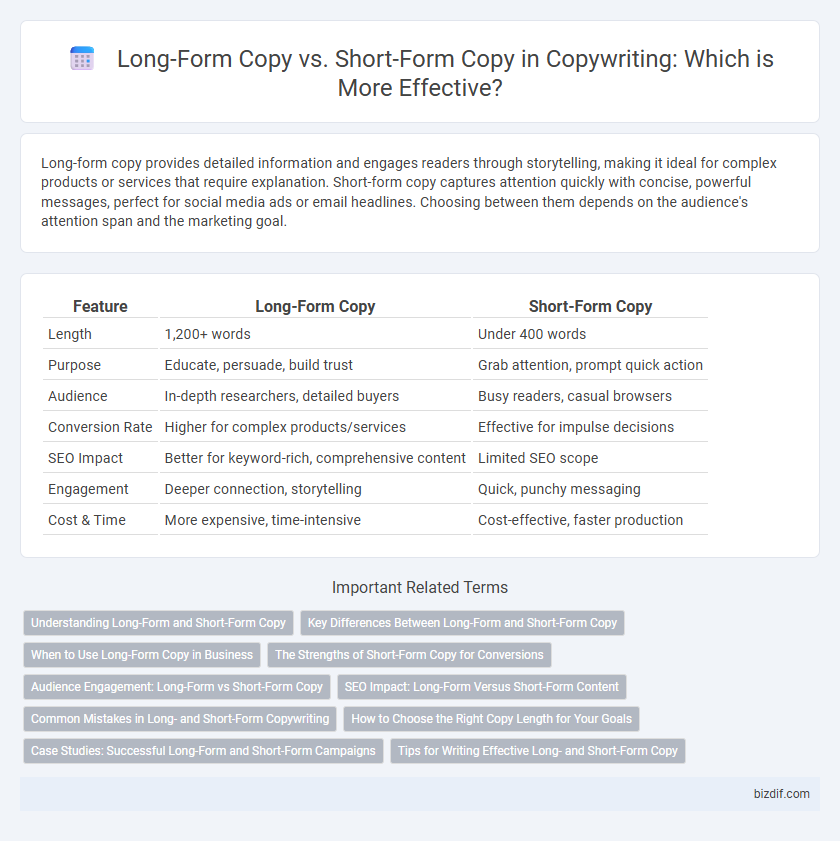Long-form copy provides detailed information and engages readers through storytelling, making it ideal for complex products or services that require explanation. Short-form copy captures attention quickly with concise, powerful messages, perfect for social media ads or email headlines. Choosing between them depends on the audience's attention span and the marketing goal.
Table of Comparison
| Feature | Long-Form Copy | Short-Form Copy |
|---|---|---|
| Length | 1,200+ words | Under 400 words |
| Purpose | Educate, persuade, build trust | Grab attention, prompt quick action |
| Audience | In-depth researchers, detailed buyers | Busy readers, casual browsers |
| Conversion Rate | Higher for complex products/services | Effective for impulse decisions |
| SEO Impact | Better for keyword-rich, comprehensive content | Limited SEO scope |
| Engagement | Deeper connection, storytelling | Quick, punchy messaging |
| Cost & Time | More expensive, time-intensive | Cost-effective, faster production |
Understanding Long-Form and Short-Form Copy
Long-form copy typically exceeds 1,200 words and is designed to provide detailed information, building trust and engaging readers through storytelling and comprehensive explanations. Short-form copy usually ranges from 50 to 300 words, focusing on concise, impactful messaging that drives immediate action or conveys a clear, persuasive argument. Both formats serve distinct purposes in copywriting strategies, with long-form excelling in depth and education, while short-form thrives in clarity and urgency.
Key Differences Between Long-Form and Short-Form Copy
Long-form copy typically exceeds 1,200 words and provides in-depth information, storytelling, and persuasive arguments aimed at nurturing leads and building trust over time. Short-form copy, often under 300 words, delivers concise, impactful messaging designed to capture attention quickly and prompt immediate action. The key differences lie in length, purpose, reader engagement, and the level of detail, with long-form suited for complex products or services and short-form ideal for quick conversions and simple calls to action.
When to Use Long-Form Copy in Business
Long-form copy is ideal for businesses aiming to educate customers, build trust, and address complex products or services in detail. It performs well in industries like technology, finance, and healthcare where thorough explanations and storytelling enhance conversion rates. Using long-form copy in sales pages, whitepapers, or detailed blog posts allows brands to engage potential buyers through comprehensive information and emotional appeal.
The Strengths of Short-Form Copy for Conversions
Short-form copy excels in capturing attention quickly, making it ideal for platforms with limited time or space, such as social media ads and email subject lines. Its concise nature reduces cognitive load, encouraging faster decision-making and higher conversion rates. Strategic use of compelling headlines, clear calls-to-action, and targeted messaging amplifies short-form copy's strength in driving immediate responses.
Audience Engagement: Long-Form vs Short-Form Copy
Long-form copy drives deeper audience engagement by providing comprehensive insights and storytelling that build trust and authority. Short-form copy captures immediate attention with concise, impactful messaging ideal for quick decision-making on social media and ads. Balancing both formats based on target audience preferences maximizes retention and conversion rates.
SEO Impact: Long-Form Versus Short-Form Content
Long-form copy, typically exceeding 1,200 words, enhances SEO by providing comprehensive coverage of topics, increasing keyword density and dwell time, which boosts search engine rankings. Short-form copy, usually under 600 words, offers quick, targeted messages ideal for conversions and social media but may lack the depth needed for strong SEO performance. Search engines favor long-form content for its ability to answer complex queries and engage readers longer, ultimately improving organic visibility.
Common Mistakes in Long- and Short-Form Copywriting
Common mistakes in long-form copywriting include overwhelming readers with excessive details and lacking clear calls-to-action, which can reduce engagement and conversion rates. Short-form copy often suffers from vagueness and insufficient information, failing to capture attention or convey the value proposition effectively. Both formats require precise targeting of audience needs and strategic message structuring to optimize response and drive better results.
How to Choose the Right Copy Length for Your Goals
Selecting the right copy length depends on your marketing goals and audience engagement. Long-form copy excels in building trust and providing detailed information for complex products, boosting conversion rates through storytelling and comprehensive benefits. Short-form copy is ideal for quick impressions, brand awareness, and driving immediate actions, especially on social media platforms where concise messaging captures attention swiftly.
Case Studies: Successful Long-Form and Short-Form Campaigns
Case studies reveal that long-form copy excels in complex sales funnels by providing comprehensive product details and storytelling, as seen in the successful campaign by Shopify that increased user engagement by 30%. Conversely, short-form copy drives immediate action in social media ads, demonstrated by Airbnb's concise and compelling ad copy that boosted conversions by 25%. These examples highlight strategic use of copy length tailored to campaign goals and audience behavior.
Tips for Writing Effective Long- and Short-Form Copy
Effective long-form copy requires in-depth research, clear structure with headings, and engaging storytelling to maintain reader interest and improve SEO rankings. Short-form copy benefits from concise language, strong calls-to-action, and focused messaging to quickly capture attention and drive conversions. Tailoring tone and style to the target audience enhances the impact of both long- and short-form copywriting efforts.
Long-Form Copy vs Short-Form Copy Infographic

 bizdif.com
bizdif.com